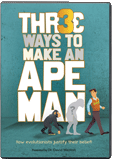
Treewalking Orangutans
News Source
- ScienceNOW: “Walk Like an Orangutan”
Although cartoons of an increasingly upright ape—steadily morphing into a craggy troglodyte—are perhaps the most widespread, popular icons of evolution, evolutionists’ theories as to how upright ambulation actually evolved have been largely hypothetical to date.
Crompton and Thorpe’s contribution is a new observation of orangutans walking upright in trees.
An entry in this week’s issue of Science aims to change that. Primatologist Robin Crompton of the University of Liverpool and graduate student Susannah Thrope are rekindling a “30-year-old hypothesis that upright walking first evolved in the trees,” reports ScienceNOW. Crompton and Thorpe’s contribution is a new observation of orangutans walking upright in trees. The authors note that this upright walking would have originally evolved in “the ancestor common to all the great apes”; chimpanzees and gorillas would have “subsequently adapted a new way of moving on all fours” while the first humans would have “retained this familiar, upright mode of walking when they moved down to the forest floor.”
Of course, evolutionists already believe—as a result of their axiomatic acceptance of evolution—that some apes, somewhere along the line, evolved the ability/propensity to walk upright, and that that group generated what could eventually be considered the first humans. Since evolutionists must believe this occurred, the exact mechanism never needs to be more than a vague “could-be” hypothesis.
What are the problems with the upright-in-the-treetops idea? First, the ScienceNOW article notes that orangutans were seen “walking upright on thin, flexible branches, which are springy, like spongy ground.” However, walking on thin tree limbs is substantially different than traversing even the spongiest soil; thin tree limbs will not support weight in the same manner. Unsurprisingly, then, the orangutans don’t actually walk “independently” upright; rather, they cling to surrounding branches and tree trunks as they move along (as seen in Crompton’s video—warning, large file size!).
Furthermore, the ScienceNOW article notes the study authors’ conclusion that:
Still, many changes were needed for habitual use of two legs. For example, their lower limbs and pelvises were remodeled to better balance the weight—and these changes still are found only in hominids that walked upright most of the time, not apes.
While evolutionists think such “remodeling” was the result of natural selection, creationists see it as a distinguishing feature of humans.
Any model of bipedal evolution will fit into the creation model.
Because evolution is an unfalsifiable paradigm of origins, the shortcomings of any particular model within evolutionary theory (or evidence to the contrary) will never be enough for evolutionists to reject Darwin’s theory. Similarly, any model of bipedal evolution will fit into the creation model; the explanation for this one, for instance, is simple: God gave orangutans the genetic information to ambulate on two limbs in certain, restricted settings. This proves evolution no more than the limited, restricted bipedalism of dogs (although we recognize that primate bipedalism is more similar to human bipedalism than canine bipedalism is).
As in so many other cases, this curious scientific observation is neutral with respect to creation or evolution; only when various presuppositional “filters” are added can this be viewed as either a key to bipedal evolution or an example of the Creator’s handiwork.
For More Information: Get Answers
Remember, if you see a news story that might merit some attention, let us know about it! (Note: if the story originates from the Associated Press, FOX News, MSNBC, the New York Times, or another major national media outlet, we will most likely have already heard about it.) And thanks to all of our readers who have submitted great news tips to us. If you didn’t catch all the latest News to Know, why not take a look to see what you’ve missed?
(Please note that links will take you directly to the source. Answers in Genesis is not responsible for content on the websites to which we refer. For more information, please see our Privacy Policy.)
Recommended Resources

Answers in Genesis is an apologetics ministry, dedicated to helping Christians defend their faith and proclaim the good news of Jesus Christ.
- Customer Service 800.778.3390
- © 2024 Answers in Genesis



